
Overview of the types of energy and how it can be stored and released.
A free CK-12 account is required to view all materials.
- Subject:
- Science
- Material Type:
- Lesson
- Provider:
- CK-12 Foundation
- Provider Set:
- CK-12 Earth Science
- Date Added:
- 11/15/2023

Overview of the types of energy and how it can be stored and released.
A free CK-12 account is required to view all materials.
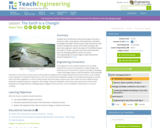
This lesson introduces and describes the main types of erosion (i.e., chemical, water, wind, glacier and temperature). Students learn examples of each type of erosion and discuss how erosion changes the surface of the Earth. Students also learn why engineers need to be aware of the different types of erosion in order to protect structures and landmarks from the damaging effects erosion can cause. Figure 1 is an excellent illustration of water erosion.

This site from Georgia State University Physics Department defines elastic potential energy and explains its origin. Provides an equation for computing elastic potential energy and an opportunity to practice solving problems with an automated problem-solver.
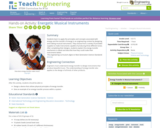
Students learn to apply the principles and concepts associated with energy and the transfer of energy in an engineering context by designing and making musical instruments. They choose from a variety of provided supplies to make instruments capable of producing three different tones. After completing their designs, students explain the energy transfer mechanism in detail and describe how they could make their instruments better.
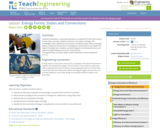
The students participate in many demonstrations during the first day of this lesson to learn basic concepts related to the forms and states of energy. This knowledge is then applied the second day as they assess various everyday objects to determine what forms of energy are transformed to accomplish the object's intended task. The students use block diagrams to illustrate the form and state of energy flowing into and out of the process.

This pathways explores how cells harvest energy using cellular respiration in eukaryotic cells and photosynthesis in plant cells.
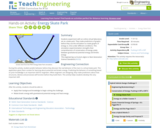
Students experiment with an online virtual laboratory set at a skate park. They make predictions of graphs before they use the simulation to create graphs of energy vs. time under different conditions. This simulation experimentation strengths their comprehension of conservation of energy solely between gravitational potential energy and kinetic energy
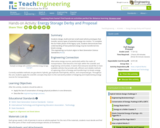
In Activity 5, as part of the Going Public step, students demonstrate their knowledge of how potential energy may be transferred into kinetic energy. Students design, build and test vehicle prototypes that transfer various types of potential energy into motion.
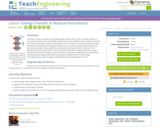
This lesson covers concepts of energy and energy transfer utilizing energy transfer in musical instruments as an example. More specifically, the lesson explains the two different ways in which energy can be transferred between a system and its environment. The law of conservation of energy will also be taught. Example systems will be presented to students (two cars on a track and a tennis ball falling to the ground) and students will be asked to make predictions and explain the energy transfer mechanisms. The engineering focus comes in clearly in the associated activity when students are asked to apply the fundamental concepts of the lesson to design a musical instrument. The systems analyzed in the lesson should help a great deal in terms of discussing how to apply conservation of energy and energy transfer to make things.
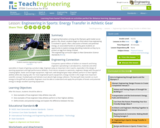
Imagining themselves arriving at the Olympic gold medal soccer game in Beijing, students begin to think about how engineering is involved in sports. After a discussion of kinetic and potential energy, an associated hands-on activity gives students an opportunity to explore energy absorbing materials as they try to protect an egg from being crushed.

A narrated tutorial which illustrates how the work-energy theorem can be expanded to include other kinds of energy. [10:07]
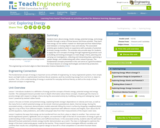
Students learn about energy, kinetic energy, potential energy, and energy transfer through a series of three lessons and three activities. They learn that energy can be neither created nor destroyed and that relationships exist between a moving object's mass and velocity. The associated activities give students hands-on experience with examples of potential-to-kinetic energy transfers. The activities also provide ways for students to apply the core concepts of energy through engineering practices such as building and testing prototypes to meet design criteria, planning and carrying out investigations, collecting and interpreting data, optimizing a system design, and collaborating with other research groups. The fundamental concepts presented in this unit serve as a good foundation for future lessons on energy technologies and electricity production.
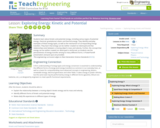
Students learn about kinetic and potential energy, including various types of potential energy: chemical, gravitational, elastic and thermal energy. They identify everyday examples of these energy types, as well as the mechanism of corresponding energy transfers. They learn that energy can be neither created nor destroyed and that relationships exist between a moving object's mass and velocity. Further, the concept that energy can be neither created nor destroyed is reinforced, as students see the pervasiveness of energy transfer among its many different forms. A PowerPoint(TM) presentation and post-quiz are provided.
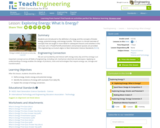
Students are introduced to the definition of energy and the concepts of kinetic energy, potential energy, and energy transfer. This lesson is a broad overview of concepts that are taught in more detail in subsequent lessons and activities in this curricular unit. A PowerPoint(TM) presentation and pre/post quizzes are provided.

Students drop water from different heights to demonstrate the conversion of water's potential energy to kinetic energy. They see how varying the height from which water is dropped affects the splash size. They follow good experiment protocol, take measurements, calculate averages and graph results. In seeing how falling water can be used to do work, they also learn how this energy transformation figures into the engineering design and construction of hydroelectric power plants, dams and reservoirs.

Discusses ways in which energy can be transferred, what kinetic energy is and types of potential energy. Includes examples of energy conversions.
A free CK-12 account is required to view all materials.

This lesson introduces the concept of gravitational potential energy. [4:26]

This lesson gives a mathematical relationship for gravitational potential energy. [7:05]
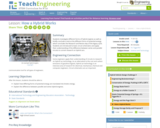
Students investigate different forms of hybrid engines as well as briefly conclude a look at the different forms of potential energy, which concludes the Research and Revise step of the legacy cycle. Students are introduced to basic circuit schematics and apply their understanding of the difference between series and parallel circuits to current research on hybrid cars.
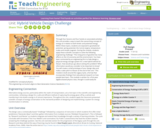
Through four lessons and four hands-on associated activities, this unit provides a way to teach the overarching concept of energy as it relates to both kinetic and potential energy. Within these topics, students are exposed to gravitational potential, spring potential, the Carnot engine, temperature scales and simple magnets. During the module, students apply these scientific concepts to solve the following engineering challenge: "The rising price of gasoline has many effects on the US economy and the environment. You have been contracted by an engineering firm to help design a physical energy storage system for a new hybrid vehicle for Nissan. How would you go about solving this problem? What information would you consider to be important to know? You will create a small prototype of your design idea and make a sales pitch to Nissan at the end of the unit." This module is built around the Legacy Cycle, a format that incorporates findings from educational research on how people best learn. This module is written for a first-year algebra-based physics class, though it could easily be modified for conceptual physics.